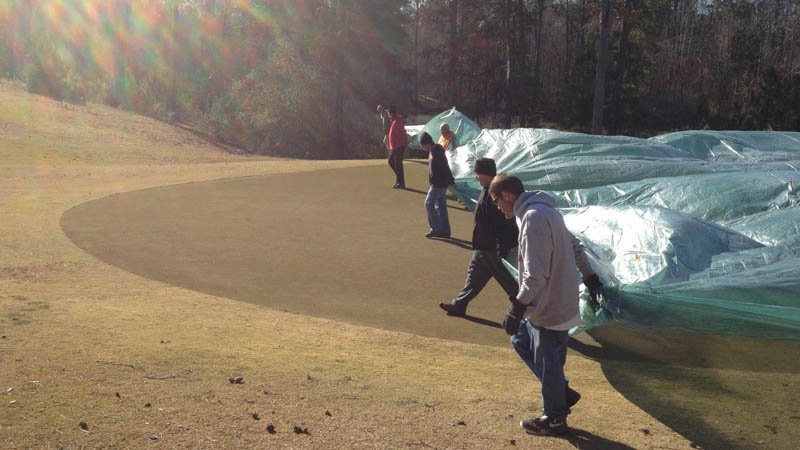
If it seems like just yesterday when superintendents managing warm-season turf were feeling the effects of lingering winter damage, it is because it was yesterday. Literally.
How to manage Bermudagrass damaged last winter was fodder for university research updates, fact sheets, webinars and field days. Although the effects of last winter are still fresh in the minds of many, like it or not, suddenly it is time to start thinking ahead to winter.
The USGA Green Section has a some tips to consider for superintendents growing Bermudagrass to consider before winter arrives and it is time to drag out those greens covers.
> Apply wetting agents before it gets really cold to maintain proper soil moisture levels. It is important to maintain adequate soil moisture in the upper rootzone of putting greens to prevent desiccation during extremely cold weather. According to University of Arkansas research, using wetting agents can help ensure adequate and uniform moisture levels that will reduce the risk of turf injury during severe winter conditions.
> Temporarily remove covers after four to five days to irrigate putting surfaces during prolonged cold weather events. High winds and low humidity often accompany extremely cold weather and can dry out the upper rootzone. Taking covers off for two to three hours and irrigating putting greens will restore rootzone moisture.
> Create an air gap under turf covers at the coldest putting green sites. Turf covers alone may not provide enough protection when temperatures drop below 15 degrees Fahrenheit. Putting greens on north-facing slopes and those with winter shade issues are prone to lower soil temperatures than other putting greens. Placing pine straw on a putting green before installing a turf cover creates an air gap between the turf and the cover that helps keep soil temperatures several degrees warmer than a cover alone. This increase in soil temperature might prevent turf injury.
> Manage winter shade. Shade will reduce soil temperatures, increasing the risk of cold temperature injury. Shaded greens are particularly susceptible to winter injury if they are not protected by a cover with an insulating air gap.
> Remember, covers are expensive, but they work. Even if covers are seldom necessary, they work. There are the cost and the hassle of deploying and removing them, but that cost is much cheaper than rebuilding greens and using them results in far less down time in spring and summer than what it takes to replace dead turf.
Recent research conducted at the University of Arkansas looked into the effects of covers on Champion, TifEagle and MiniVerde greens at 25 degrees, 22 degrees, 18 degrees and 15 degrees Fahrenheit. According to the study, TifEagle and MiniVerde were more cold tolerant than Champion.
According to the study, Bermudagrass greens covered when temperatures reached 15 degrees survived throughout the winter with improved spring green up. Covered greens even survived two days of extreme cold temperatures where overnight lows dropped to 0 degrees on consecutive nights.

